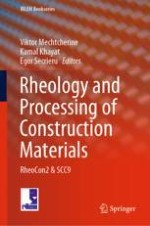2020 | OriginalPaper | Buchkapitel
SCC for Sub-Saharan Africa Based on Local Raw Materials – Material Development, Optimisation, and Application Concept
verfasst von : Wolfram Schmidt
Erschienen in: Rheology and Processing of Construction Materials
Aktivieren Sie unsere intelligente Suche, um passende Fachinhalte oder Patente zu finden.
Wählen Sie Textabschnitte aus um mit Künstlicher Intelligenz passenden Patente zu finden. powered by
Markieren Sie Textabschnitte, um KI-gestützt weitere passende Inhalte zu finden. powered by
